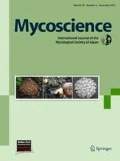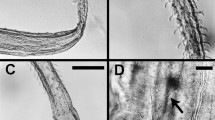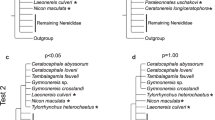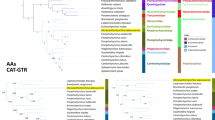Abstract
Geastrum melanocephalum, originally described as Trichaster melanocephalus, is characterized by large basidiomata and an evanescent endoperidium. Although Trichaster was recently treated as a synonym of Geastrum and the specific name G. melanocephalum has often been used, it is still controversial whether Trichaster is an independent genus. Although a close affinity of G. melanocephalum and G. triplex has been suggested based on some morphological similarities, it is highly likely that G. triplex is polyphyletic because of its high morphological variability. To clarify the phylogenetic position of G. melanocephalum, it is therefore critical to evaluate the monophyly of G. triplex. This study sampled ITS, LSU, and atp6 genes from 144 specimens of Geastrales including G. melanocephalum and G. triplex from several continents. Results of phylogenetic analyses demonstrated G. melanocephalum is nested within Geastrum and is most closely related to the European and North American group of G. triplex. Morphological similarities of G. melanocephalum and European and North American G. triplex are also suggested. Based on phylogenetic and morphological evidence, we confirm Trichaster is a synonym of Geastrum, and the scientific name Geastrum melanocephalum should be accepted. Moreover, the present study revealed that taxa tentatively identified as “G. triplex” are highly polyphyletic, and a taxonomic revision of “G. triplex” is therefore needed.





Similar content being viewed by others
References
Agerer R, Beenken L (1998) Geastrum fimbriatum Fr. + Fagus sylvatica L. Descr Ectomycorrhizae 3:13–18
Benkert D (1973) Űber neufunde seltener Gasteromyceten in Brandenburg. Gleditschia 1:113–121
Calonge FD (1998) Gasteromycetes 1. Lycoperdales, Nidulariales, Phallales, Sclerodermatales, Tulostomatales. Flora Mycologica Iberica, vol 3. Real Jardín Botánico, Madrid
Calonge FD, Telleria MT, Verde L, de la Torre M (1978) Una “estrella de tierra” rara: Geastrum melanocephalum (Czern.) Staněk. Bol Soc Micol Castellana 3:30–32
Cunningham GH (1927) Lycoperdaceae of New Zealand. Trans R Soc N Z 57:187–217
Czerniaiev BM (1845) Nouveaux cryptogames de l’Ukraine et quelques mots sur la flore de ce pays. Bull Soc Imp Nat Moscau 18:132–157
Demoulin V (1968) Gastéromycètes de Belgique: Sclerodermatales, Tulostomatales, Lycoperdales. Bull Jard Bot Natl Belg 38:1–101
Dissing H, Lange M (1961) The genus Geastrum in Denmark. Bot Tidsskr 57:1–27
Domínguez de Toledo LS, Castellano MA (1996) A revision of the genus Radiigera and Pyrenogaster. Mycologia 88:863–884
Dörfelt H (1985) Erdsterne: Geastraceae und Astraeaceae. Ziemsen Verlag, Wittenberg
Dörfelt H, Kreisel H, Benkert D (1979) Die Erdsterne (Geastrales) der Deutschen Demokratischen Republik. Hercynia N F 16:1–56
Douanla-Meli C, Langer E, Calonge FD (2005) Geastrum pleosporus sp. nov., a new species of Geastraceae identified by morphological and molecular phylogenetic data. Mycol Prog 4:239–250
Edgar RC (2004a) MUSCLE: multiple sequence alignment with high accuracy and high throughput. Nucleic Acids Res 32:1792–1797
Edgar RC (2004b) MUSCLE: a multiple sequence alignment method with reduced time and space complexity. BMC Bioinform 5:113
Flegler SL (1984) An improved method for production of Sphaerobolus fruit bodies in culture. Mycologia 76:944–946
Geml J, Davis DD, Geiser DM (2005) Systematics of the genus Sphaerobolus based on molecular and morphological data, with the description of Sphaerobolus ingoldii sp. nov. Mycologia 97:680–694
Hall TA (1999) BioEdit: a user-friendly biological sequence alignment editor and analysis program for Windows 95/98/NT. Nucleic Acids Symp Ser 41:95–98
Hollós L (1913) Zu den “Gasteromyceten Ungarns”. Magyar Botanikai Lapok 12:194–200
Hosaka K (2009) Phylogeography of the genus Pisolithus revisited with some additional taxa from New Caledonia and Japan. Bull Natl Mus Nat Sci Ser B 35:151–167
Hosaka K, Castellano MA (2008) Molecular phylogenetics of Geastrales with special emphasis on the position of Sclerogaster. Bull Natl Mus Nat Sci Ser B 34:161–173
Hosaka K, Bates ST, Beever RE, Castellano MA, Colgan W, Dominguez LS, Geml J, Giachini AJ, Kenney SR, Nouhra ER, Simpson NB, Spatafora JW, Trappe JM (2006) Molecular phylogenetics of the gomphoid-phalloid fungi with an establishment of the new subclass Phallomycetidae and two new orders. Mycologia 98:949–959
Hosaka K, Castellano MA, Spatafora JW (2008) Biogeography of Hysterangiales (Phallomycetidae, Basidiomycota). Mycol Res 112:448–462
Hosaka K, Kasuya T, Reynolds HT, Sung GH (2010) A new record of Elaphomyces guangdongensis (Elaphomycetaceae, Eurotiales, Fungi) from Taiwan. Bull Natl Mus Nat Sci Ser B 36:107–115
Huelsenbeck JP, Ronquist F (2001) MRBAYES: Bayesian inference of phylogeny. Bioinformatics 17:754–755
Hultén E (1958) Trichaster melanocephalus Czern. funnen på Öland. Bot Notiser 111:390–393
Ito S (1959) Mycological flora of Japan, vol 2, no. 5. Yokendo, Tokyo
Junghuhn F (1840) Nova genera et species plantarum florae Javanicae. Tijdschrift voor Natuurlijke Geschiedenis en Physiologie 7:285–317
Kasuya T, Smaoui A (2008) Geastrum minimum, a new record of Geastraceae from Tunisia. Mycol Balcan 5:77–80
Kasuya T, Yamamoto Y, Sakamoto H, Takehashi S, Hoshino T, Kobayashi T (2009) Floristic study of Geastrum in Japan: three new records for Japanese mycobiota and reexamination of the authentic specimen of Geastrum minus reported by Sanshi Imai. Mycoscience 50:84–93
Kers LE (1975) Trichaster melanocephalus (Gasteromycetes) en problematisk art funnen på en ny lokal i Sverige. Svensk Bot Tidskr 69:175–180
Kers LE (1976) Rapport om Trichaster och Myriostoma (Gasteromycetes) i Sverige. Svensk Bot Tidskr 70:293–297
Kretzer A, Bruns TD (1999) Use of atp6 in fungal phylogenetics: an example from the Boletales. Mol Phylogenet Evol 13:483–492
Lloyd CG (1904) The genus Trichaster. Mycol Notes 18:189–190
Lohwag H (1925) Trichaster melanocephalus Czern. Arch Protist 51:305–320
Long WH (1945) Studies in the Gasteromycetes XI. The genera Trichaster and Terrostella. Mycologia 37:601–608
Rimóczi I, Jeppson M, Benedek L (2011) Characteristic and rare species of Gasteromycetes in Eupannonicum. Fungi non Delineati 56–57:1–230
Seutin G, White BN, Boag PT (1991) Preservation of avian blood and tissue samples for DNA analyses. Can J Zool 69:82–90
Shvarcman SR, Filimonova NM (1970) Gasteromicety—Gasteromycetes. Flora Sporovych Rastenij Kazachstana, tome IV. Nauka Academica SSR, Alma-Ata
Smith AH (1951) Puffballs and their allies in Michigan. University of Michigan Press, Ann Arbor
Smith CW, Ponce de Leon P (1982) Hawaiian geastroid fungi. Mycologia 74:712–717
Staněk VJ (1956) Hvezdovka Smardova—Geastrum Smardae sp. n. Česka Mykol 10:18–23
Staněk VJ (1958) Geastraceae. In: Pilát A (ed) Flora ČSR B-1, Gasteromycetes. Československé Akademie, Praha, pp 392–526
Stasińska M (2007) Nowe stanowiska gwiazdosza rudawego Geastrum refescens Pers.: Pers. i włosogwiazda czarnogłowego Trichaster melanocephalus Czern. na Pomorzu Zachodnim. Chrońmy Przyrodę Ojczystą 63:87–92
Sunhede S (1977) Morphology and intraspecific variation in Geastrum triplex Jungh. Bot Notiser 130:403–416
Sunhede S (1989) Geastraceae (Basidiomycotina). Synopsis Fungorum, vol 1. Fungiflora, Oslo
Sunhede S, Carlsson RG (2009) Trichaster melanocephalus i sydvastra Sveriges inland. Svensk Mykol Tidskr 30:5–16
Swofford DL (2002) PAUP*: phylogenetic analysis using parsimony and other methods (*PAUP version 4.0 beta 10). Sinauer, Sunderland
Uzelac B (2009) Gljibe Srbije i zapadnog Balkana. BGV Logik, Beograd
Van Eyndhoven GL, Handke HH, Lange M, Palmer JT (1958) Interesting Belgian Gasteromycetes with observations on the development of Trichaster melanocephalus Czern. Bull Jard Bot État Brux 28:161–171
Vilgalys R, Hester M (1990) Rapid genetic identification and mapping of enzymatically amplified DNA from several Cryptococcus species. J Bacteriol 172:4238–4246
White TJ, Bruns T, Lee S, Taylor JW (1990) Amplification and direct sequencing of fungal ribosomal RNA genes for phylogenetics. In: Innis MA, Gelfand DH, Sninsky JJ, White TJ (eds) PCR protocols. Academic Press, New York, pp 315–322
Zhou T, Chen Y, Zhao L, Fu H, Yang B (2007) Geastraceae, Nidulariaceae. Flora fungorum sinicorum, vol 36. Science Press, Beijing
Acknowledgments
The authors thank Dr. Stellan Sunhede for his valuable cooperation in the fieldwork and in preparation of the manuscript. We also express our sincere thanks to Dr. Jun-ichi Peter Abe, Ms. Yumiko Hirayama, Dr. Tsuyoshi Hosoya, Mr. Tomohiro Miyanaga, Mr. Haruo Sakamoto, Ms. Pota Siriporn, and Dr. Yuichi Yamaoka for encouraging and assisting our laboratory work. Thanks also go to Dr. Tamotsu Hoshino, Mr. Shinya Kotoku, Ms. Hideko Miwa, Dr. Takuo Sawahata, Mr. Masahito Taniguchi, Mr. Akitomo Uchida, Mr. Yukinori Yamamoto, and members of the biology club of Mito Daiichi High School for collecting Geastrum specimens. We also thank curators of the following mycological herbaria for kindly arranging and providing fungal specimens for this work: C, CORD, F, K, L, PDD, QCNE, S, SAPA, and TENN. This research was financed in part by a JSPS grant-in-aid (No. 222635) and a grant from the Tokai Board of Education, Ibaraki Prefecture, to T.K., and also by a JSPS grant-in-aid for young scientists B (No. 21770096) and a grant from the Institute for Fermentation, Osaka (IFO) to K.H.. This work is in partial fulfillment of the requirements for the Ph.D. degree for T.K.
Author information
Authors and Affiliations
Corresponding author
About this article
Cite this article
Kasuya, T., Hosaka, K., Uno, K. et al. Phylogenetic placement of Geastrum melanocephalum and polyphyly of Geastrum triplex . Mycoscience 53, 411–426 (2012). https://doi.org/10.1007/s10267-012-0186-z
Received:
Accepted:
Published:
Issue Date:
DOI: https://doi.org/10.1007/s10267-012-0186-z




